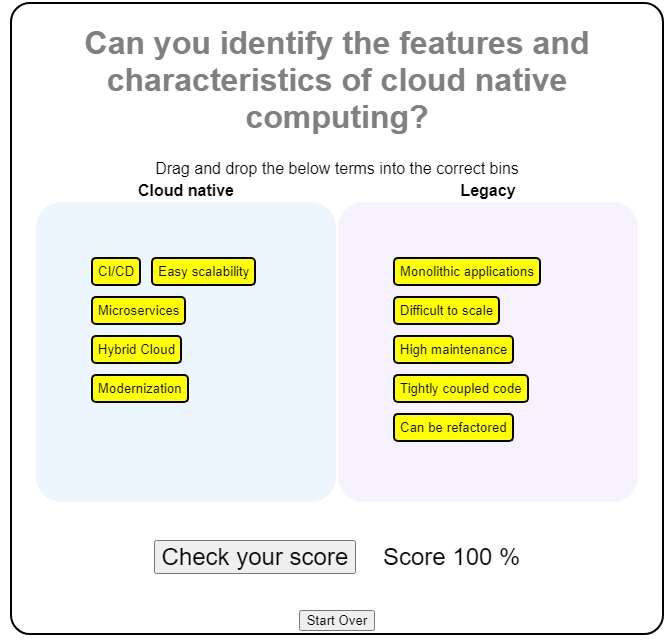| Training For Going Cloud Native |
| Written by Sue Gee |
| Wednesday, 01 June 2022 |
|
The digital transformation that is currently in full swing means a huge demand for developers with cloud computing skills. Cloud native is changing the way software development is done and here we look at online training for acquiring the requisite know-how. Here we look at three offerings from Udacity, edX and Coursera - but when you look more closely edX and Coursera both offer essentially the same course. "Developing Cloud Native Applications" from IBM. On Coursera this is described as being at Intermediate level and requiring around 14 hours to complete, although the six modules are each allocated a week. On edX it's a 2-week course needing 6-8 hours per week. The most important difference is that if you don't want a Verified Certificate at the end of the course you can "Audit" it for free on edX, which allows you 3 weeks access to the materials. You can upgrade at any time to the certificate track, which also gives you access to the graded assessments including a final exam, for $49. On Coursera there's a 7-day free trial - plenty of time to complete this particular course - and you pay a monthly subscription of $49. The six modules in Developing Cloud Native Applications are: Module 1 Introduction to Cloud native Module 2 - Getting Started with IBM Cloud Module 3 - IBM Cloud CLI Module 4 - DevOps on IBM Cloud Module 5 - REST Architecture and Watson API Module 6 - Introduction to Data Services in IBM Cloud By the end of Module 1 you will appreciate the advantages of cloud native computing and will have learned that:
After the first module, learning becomes hands on and in order to complete labs, and the final project, you'll need to create an IBM Cloud account. A feature code is provided so that you won't get charged, nor will you need a credit card. By the end of the second module learners will be able to:
In the Final Project, which is expected to take 3 hours, you are asked to building your own IBM Cloudant connected, CI/CD enabled application. The scenario is that a previous developer has developed the basic code for an application that allows the public to create movie reviews to be stored in GitHub. The task is to refine the existing code using Cloud Foundry and host the application on IBM Cloud. To achieve this, you must fork the GitHub code to your own repo, and then create the required services in your IBM Cloud account and connect them to the application. This is a peer-graded assignment and is worth 20 marks of the total grade for this course. Both on Coursera and edX this course is the third of four courses in a larger credential - the IBM Cloud Application Development Foundations Specialization in the case of Coursera and the Professional Certificate in IBM Cloud Application Development Foundations on edX. The other courses, all from IBM with Coursera timings, are:
The latest addition to Udacity's School of Cloud Computing is a 4-month Nanodegree program in Cloud Native Application Architecture. The prerequisites are familiarity with HTTP, Python, Git, Linux and Docker and the Overview states: In this program, students will learn to run and manage scalable applications in a cloud native environment, using open source tools and projects like ArgoCD, gRPC and Grafana. Students will learn to identify the best application architecture solutions for an organization’s needs, design a microservice architecture by leveraging cloud native tools and patterns, implement best practices in Kubernetes security, and use dashboards to diagnose, troubleshoot and improve site reliability. This Udacity Nangodegree goes further and is more demanding than the IBM credential and covers a range of open source technologies. There are four courses in the program and each typically has 5 lessons. What you learn is put into practice immediately in a hands-on project. Course 1: Cloud Native Fundamentals Course 2: Message Passing Course 3: Observability Course 4: Microservices Security This a lot to cover in 4 months and around 10 hours effort is required per week. It also has a relatively high cost $399 per month or $1696 if you pay for 4-month access upfront, a discount of 15%. Remember however that Udacity offers personalized discounts and it offers with technical mentor support, prompt personalized feedback from project reviewers and career support to its students. More InformationDeveloping Cloud Native Applications - edX Developing Cloud Native Applications - Coursera IBM Cloud Application Development Foundations Specialization - Coursera Professional Certificate in IBM Cloud Application Development Foundations - edX Cloud Native Application Architecture Nanodegree - Udacity Related ArticlesNew Udacity Cloud Nanodegree Programs Udacity's School of Cloud Computing Microsoft and Udacity Partner To Offer Azure Machine Learning Nanodegree Professional Credentials For Computer Science Careers To be informed about new articles on I Programmer, sign up for our weekly newsletter, subscribe to the RSS feed and follow us on Twitter, Facebook or Linkedin.
Comments
or email your comment to: comments@i-programmer.info |
| Last Updated ( Wednesday, 01 June 2022 ) |





